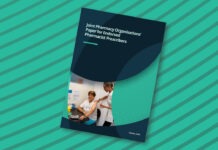The Interim Report of the Review of Pharmacy Remuneration and Regulation (RPRR) arrived on 22 June and the world of pharmacy as we know it didn’t end.
In fact, given the Federal Government’s 2017 Budget announcements on location rules and the Community Service Obligation a significant chunk of the Review’s options were pretty much dead on arrival.
Like its predecessor, the Review discussion paper, the Interim Report prepared by the Review Panel – Professor Stephen King, Jo Watson and Bill Scott – covers a lot of territory, 47 options in all.
However, before looking at these the Interim Report needs to be placed into context within the broader review process.
First, it should be emphasised it does not contain final recommendations. The reviewers invited further submissions commenting on the options. The Review Panel also held consultations with ‘a select group of stakeholders.’ PSA met with the panel in late June.
In a Message from the Chair released with the report, Professor Stephen King said there had been ‘considerable deliberation’ among the Panel Members over the reform pathways presented in the Interim Report that were underpinned by ‘a common vision of an integrated and sustainable community pharmacy sector,’ which was adaptive to the inevitable changes in healthcare given Australia’s ageing population, rapid advances in technology and ongoing Pharmaceutical Benefits Scheme (PBS) reform.
‘Accordingly, our intent is to develop a flexible framework for community pharmacy remuneration and regulation, consistent with a 20-year timeframe, encouraging of innovation whilst adaptable to the changing needs of the Australian public and broader healthcare system.’
‘Consistent with the Review’s Terms of Reference, the Panel has considered foremost arrangements that support consumer access – the safe, efficient and effective distribution of medicines listed on the PBS to Australians who need them, regardless of location – consistent with the National Medicines Policy.’
Professor King also said issues covered by the Interim Report were complex, with the potential to impact significantly on community pharmacy. For this reason, the Panel had decided to present options instead of draft recommendations.
‘Many of these options were raised by stakeholders in our consultations or in their written submissions and responses to the online survey. The options were also informed by evidence independently gathered by the Review and analysed by various consultancies. Consequently, the options reflect both evolutionary and more transformative reform pathways intended to strengthen the community pharmacy sector,’ Professor King said.
It is worth noting Professor King also said the Panel had worked to ensure the issues associated with pharmacy remuneration and regulation were properly scrutinised in the Interim Report consistent with its commitment ‘that no new matters will be introduced in the Final Report.’
‘As such, alternative and mutually exclusive options are presented in certain instances where multiple reform pathways are being considered ahead of the finalisation of the Final Report.’
Community Pharmacy Agreements
On the subject of future Community Pharmacy Agreements (CPAs), the Interim Report said other ‘directly affected parties’ also needed to be included in CPA discussions.
‘In particular, the Consumers Health Forum of Australia (CHF) (as the peak representative consumer body in Australia on health-related matters) and the Pharmaceutical Society of Australia (as the peak representative body for pharmacists in Australia) should be included in CPA discussions and (if the process still leads to ‘signatories’) these bodies should also be signatories to the agreement.’
PSA National President Dr Shane Jackson said PSA was delighted the Panel had recommended involving it in future CPA negotiations.
‘Having PSA at the table for these discussions is a smart move. It will add considerable value to future Agreements by including PSA’s recognised expertise as well as giving a voice to all pharmacists working to deliver services to the community; this is something PSA, our members and consumers have advocated for more than a decade,’ Dr Jackson said.
The CHF welcomed the reviewers’ suggestion that it should be a signatory to future CPAs. However, the Society of Hospital Pharmacists of Australia expressed disappointment it was not included as a potential signatory.
The Pharmacy Guild of Australia said including the CHF in future agreements made no sense and was only called for by the CHF. However, it made no comment about including PSA.
Consumer response
CHF spokesman Mark Metherall said much of the report was positive for consumers, including an expansion of trading hours, the provision of consumer medicine information leaflets and streamlining of Pharmaceutical Benefits Scheme safety net provisions.
An option to establish an easily accessible and searchable ‘atlas’ of all community pharmacies providing patient information on services and opening hours was also welcomed.
Areas of concern
The Medicines Partnership of Australia (MPA), the nation’s pharmaceutical supply chain peak body (which includes PSA), expressed concern that some options would have significant unintended consequences for the industry and a negative impact on consumers.
The Interim Report, outlined what the MPA described as several key options for change in the pharmaceutical supply chain, including increased pharmacy regulation, changes to PBS pricing rules, abolition of the optional $1 discount of the patient co-payment, the introduction of tendering for generic medicines and several options for removing, retaining or replacing the existing Community Service Obligation (CSO) for wholesalers.
MPA Chair Donna Staunton said, the MPA was concerned about the consequences of some of the proposed changes as they might ultimately increase prices and reduce choices for consumers, and threaten patient accessibility to critical medicines.
‘It is almost as if they have started from a fixed end point and then attempted to find evidence to support that point of view.
‘The Australian pharmaceutical industry has been identified as one of the key sectors for our nation’s future economic success. Last month, we took a positive step forward with the Federal Budget funding announcements, but we view this Interim Report in many ways, as a step backwards that has the potential to harm the future growth of the sector,’ Ms Staunton said.
Dr Jackson said PSA was concerned about the implication that pharmacy could give back $1.9 billion over the next four years through a flat dispensing fee option of between $9 and $11.50, particularly given the heavy impact of price disclosure.
‘We are seriously concerned about the flow-on effects of this for pharmacists’ wages – the main cause of dissatisfaction in the profession. While the Interim Report acknowledges the positive impact of a range of pharmacists’ services, it’s vague on presenting concrete options for progressing services to benefit consumers.’
Medicines Australia (MA) Chief Executive Milton Catelin said proposed changes to the supply chain model and choice of medicines for patients were a concern.
He said a number of ideas put forward in the Interim Report were of real concern to MA as they were either ineffective, could potentially diminish medicine quality or lead to potential medicines shortages for patients.
These included:
- Reducing competition in off-patent medicines by tendering for a maximum of five suppliers (four generic manufacturers and the original branded supplier) per medicine.
- Changes to chemotherapy compounding payments and minimum standards that would allow non-TGA approved compounding facilities to offer chemotherapy compounding.
- Removal, retention or replacement of the Community Service Obligation (CSO).
Mr Catelin said tenders were already utilised by Australian hospitals for off-patent medicines and had been problematic with acute shortages of medicines becoming more common.
‘Any move towards a tender-based PBS would be a retrograde step that would limit choice for consumers, increase the risk of medicines supply shortages and could ultimately lead to higher long-term average costs for off-patent medicines on the PBS,’ he said.
Further, the report did not take into account recent reforms negotiated between MA and the Government that would have a significant impact on reducing the prices paid for medicines that would see generics present even greater value to patients in the future.
National Pharmaceutical Services Association (NPSA) Chair Mark Hooper agreed, describing the document as ‘extremely disappointing’, lacking in rigour and failing to identify any consequences of its recommendations.
‘We already have medicines shortages in Australia, so we fail to see how a proposal to effectively shift away from a hub and spoke distribution model with in-built redundancy will alleviate this or enhance access to essential medicines for consumers,’ he said.
He said it was particularly disappointing the Panel chose to make supply chain suggestions that appeared to fundamentally ignore not only submissions provided by the CSO wholesalers but also those of the Pharmacy Guild, Medicines Australia and individual manufacturers.
‘It is perplexing that the Panel acknowledges that its Review had “not been concerned with the specifics of implementation”, then proceeds to impose an onus for distribution of medicines on manufacturers – and that is simply not practical,’ Mr Hooper said.
Welcome recognition
Regardless of the merits or otherwise of the options presented in the Interim Report, it may be remembered by pharmacists for one thing.
The reviewers recognised that ‘community pharmacy plays a vital role in the Australian healthcare system, not just in dispensing medicines and medicines advice but also as an accessible source of reliable healthcare advice and services.’ (Page 136.)
It also recognised that many pharmacy services are not funded.
The RPRR Discussion Paper released in 2016 noted submissions by stakeholders which said the skills, knowledge and expertise of pharmacists were underutilised in the health system.’
The Interim Report took this a step further saying, ‘Subsequent consultations have reinforced this view, and the Panel believes that there is significant opportunity to better utilise the skills of pharmacists to support improved access to health services and improved health outcomes for the community.’
It also noted the PSA submission had advocated, ‘the need to better utilise pharmacists’ skills through the support and remuneration of appropriate evidenced-based services.’
This acknowledgement dovetails with what Dr Jackson wrote in his first President column in the July issue of Australian Pharmacist.
He wrote: ‘We must be focussed on achieving roles and activities for pharmacists that are professionally rewarding, that underpin the viability of community pharmacy, but that are also focussed on developing new roles for pharmacists that may lie outside of traditional spheres. Any activities that are developed for pharmacists in the future, including current roles must also be remunerated in a way that acknowledge the significant training and expertise that a pharmacist possesses.’
‘My intent is for us to be able to say that pharmacists are used across the healthcare system for their skills as medicines experts, instead of the oft-quoted phrase that we are the most underutilised,’ Dr Jackson said.
No doubt, the Reviewers’ acknowledgment of a ‘significant opportunity to better utilise the skills of pharmacists’ will be quoted back to governments across Australia for many years to come.
In Option 8-2, the reviewers also outlined key principles they believed programs offered by community pharmacy should be underpinned by. The principles were:
- be based on evidence of effectiveness
- may or may not involve government paying for some or all of the cost of the service to some or all patients
- may in some cases be offered on the basis of each community pharmacy choosing whether or not to offer the program (with all community pharmacies being eligible to offer the program). In other cases, the program will only be available (with government payment) through pharmacies/ pharmacists that are selected by the government (for example, through a tender process or as a result of negotiation between the government and the relevant pharmacies or pharmacists)
- for some programs, government remuneration for the program will be channelled through the users of the program (or their representatives) so that the users will decide which community pharmacies (or pharmacists) to use to deliver the program
- adequate funding for the above needs to be found outside PBS expenditure.
The deadline for comments and feedback on the Interim Report closed on 23 July. Now the wait for the final report, its recommendations and the federal Government’s response begins!
All going well it could be delivered to the Federal Government by mid-September.
PSA’s response
In its response PSA welcomed the Review Panel’s recognition of a ‘significant opportunity to better utilise the skills of pharmacists to support improved access to health services and improved health outcomes for the community.’
It also welcomed options seeking a more flexible approach to pharmacy service delivery and support for ‘integration of healthcare services, while also encouraging innovation in business models,’ as they were a key focus of PSA’s review submission.
Other options presented in the Interim Report that were proposed by PSA in its submission, included:
- Abolishing the $1 discount on the PBS patient co-payment.
- Increasing the cap on HMRs, combined with more targeted eligibility criteria based on need.
- Diversifying and broadening the remuneration base for pharmacists and pharmacies outside of PBS expenditure.
- Payment for services delivered in pharmacies to match those delivered in other health services (e.g. pharmacist-administered vaccinations).
- Homeopathic products should not be sold in PBS-approved pharmacies.
- Trialling employment of pharmacists in Aboriginal Health Service to see if it improves services and outcomes for Indigenous Australians.
Last month PSA submitted a detailed response to the Interim Report after consulting with members.
Sifting through the options
The Interim Report contains a wide variety of options – some received wide coverage while some received almost none. A few of the more interesting ones potentially affecting pharmacists are outlined below.
Harmonising state pharmacy legislation
According to the reviewers the community pharmacy sector is subject to a complex array of regulations made by state and territory governments as well as the Australian Government.
Option 5-9 suggests the Australian Government, through the Australian Health Minister’s Advisory Council, should seek to harmonise all state, territory and federal pharmacy regulations ‘to simplify the monitoring of pharmacy regulation in Australia for the safety of the public.’
Further, in the long term, ‘a single pharmacy regulator could be considered.’ They suggest as an interim measure, state and territory registering bodies need to coordinate with the Australian Health Practitioner Regulation Agency to ensure pharmacy regulations are adequately monitored for best practice of pharmacy and the safety of the public.
Complementary medicines
In Option 3-2 the reviewers said consumers valued access to complementary medicines in community pharmacies, where they could receive advice on their selection and use backed by an appropriate level of evidence. They encouraged community pharmacists to:
- ‘display complementary medicines for sale in a separate area where customers can easily access a pharmacist for appropriate advice on their selection and use;
- provide appropriate information to consumers on the extent of, or limitations to, the Therapeutic Goods Administration (TGA) role in the approval of complementary medicines. This could be achieved through the provision of appropriate signage (in the area in which these products are sold) that clearly references any limitations on the medical efficacy of these products noted by the TGA.’
Homeopathic products
The reviewers (Option 3-4) said there were unacceptable risks where community pharmacies were allowed to sell homeopathic products. ‘Homeopathy and homeopathic products should not be sold in PBS-approved pharmacies. This requirement should be referenced and enforced through relevant policies, standards and guidelines issued by professional pharmacy bodies.’
S2/S3 medicines
In the area of Pharmacy Only (S2) and Pharmacist Only (S3) medicines the reviewers said complementary medicines posed a risk to consumers when they were not clearly separated from S2 and S3 medicines.
Option 3-3 suggested access to S2 and S3 medicines should be clearly separated from complementary medicines within a pharmacy. Ways to achieve this might include:
- ‘ensuring that all Pharmacy Only and Pharmacist Only medicines only be accessible from “behind the counter” in a community pharmacy so that a consumer must always seek assistance or advice in obtaining these medicines
- requiring that complementary medicines are not displayed “behind the counter” in a community pharmacy.’
Procedures and remuneration for supplying high-cost medicines
According to the Interim Report, the supply of complex and high-cost medicines does not sit well within existing supply chain and pharmacy remuneration arrangements and supplying these medicines is a ‘significant concern for a number of pharmacies.’ Option 6-2 says patients should be able to receive high-cost medicines from the community pharmacy of their choice: ‘A cap should be placed on the amount that a community pharmacy contributes to the cost of a medicine. This cap should be in the range of $700 to $1,000 so that all PBS-approved community pharmacies can supply all PBS medicines required by the public.’
Machine dispensing
The Interim Report notes that overseas experience has demonstrated advantages in the use of remote dispensing machines. Option 10-6 suggests ‘the government trial the use of machine dispensing in a small number of relevant secure locations in communities that are not currently adequately served by community pharmacy. Such machine dispensing should be appropriately supervised and allow real-time interaction with a remote pharmacist. The range of PBS medicines available through machine dispensing also needs to be limited and should be based on an assessment of risk.’
A pharmacy atlas
The reviewers (Option 2-5) said information about pharmacy services is inconsistent and inadequate to support sufficient consumer awareness and choice. They suggest there should be an easily accessible and searchable ‘atlas’ of all community pharmacies in Australia providing key patient information, including the services and programs offered by pharmacies, their opening hours and any specific accessibility services the pharmacy provides (e.g. multilingual staff ). The ‘atlas’ should also be easily accessible to consumers (e.g. through mobile-friendly applications).



 PSA Vice President Professor Mark Naunton MPS[/caption]
PSA Vice President Professor Mark Naunton MPS[/caption]




 Dr Louise Schaper at PSA25[/caption]
Dr Louise Schaper at PSA25[/caption]





